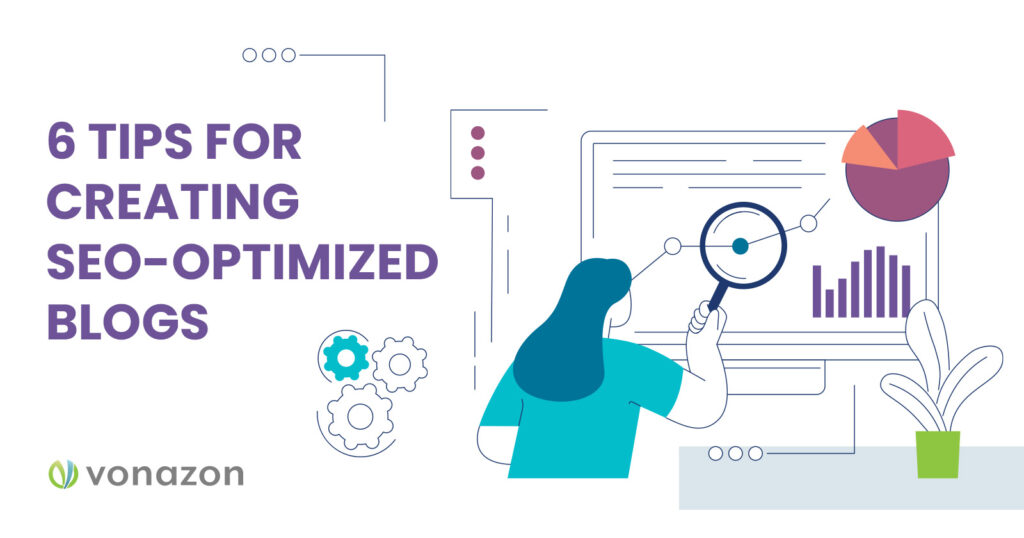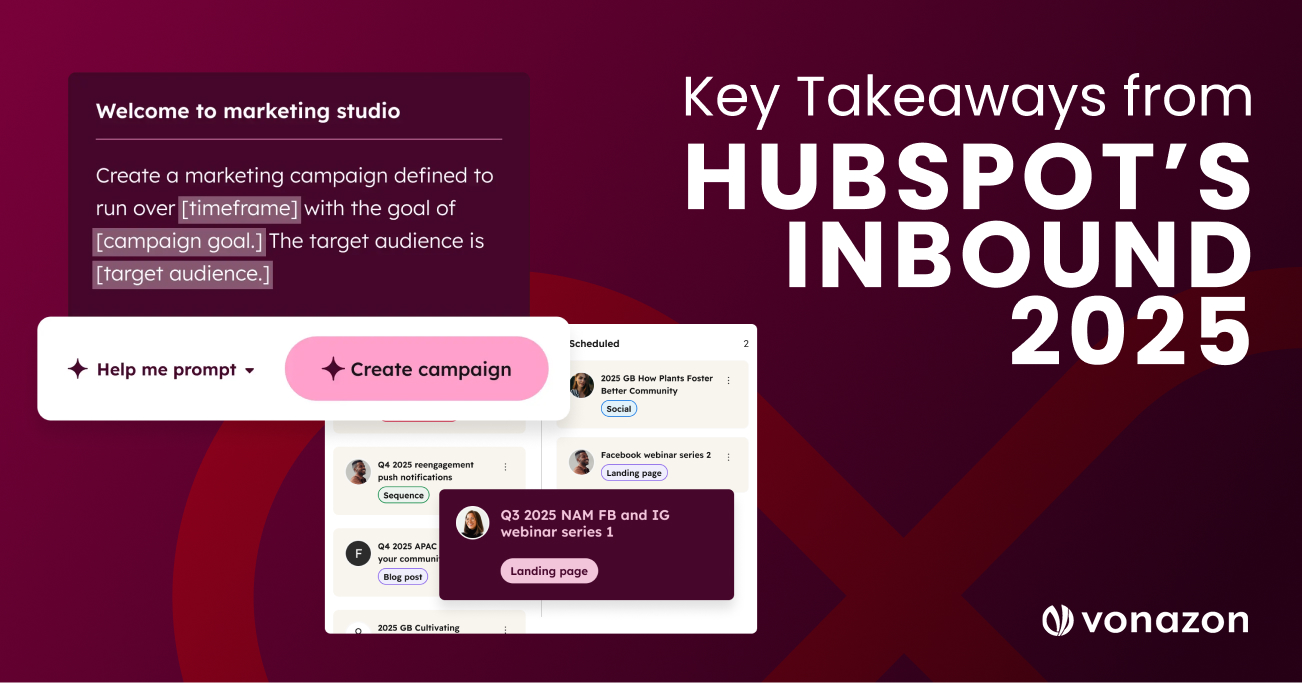6 Tips for Creating SEO-Optimized Blogs
A MARKETER’S GUIDE TO OPTIMIZING CONTENT
Are you wondering how do blogs help SEO? Here are 6 tips for optimizing content that answer the question.
The importance of search engine optimization (SEO) cannot be overstated. HubSpot research shows that 56% of consumers have purchased after reading a blog post.
An effective SEO strategy optimizes content not just for search engines like Google, but for the user experiences that drive business growth. Creating blog content optimized for search engines can significantly enhance a brand’s online presence, boost SEO, and increase site traffic, allowing prospects to better understand the value of your product or service.
1. Provide Quality Content
This is the single most important SEO factor. Google’s job is to direct users to high-quality, informative, and relevant content. Quality content signals to Google that the site is active and engaging for users. To let Google know your content is qualitative, structural elements must match the content. Here are some questions that can help determine if you are creating quality content:
- Is it well-written?
- Does it educate?
- Does it mislead?
- Does the content match the title tag, URL, and meta description?
Google uses your Title tag, URL, and meta description to understand what your article is about. Another ranking factor used by Google and other search engines is the Click Through Rate (CTR). CTR is a metric used to measure the ratio of users who click on a specific link to the number of total users who view a page, an ad, or a search engine result. An easy SEO win is to use the current year in your title to positively affect CTR, which can result in higher rankings. Just remember to refresh the content and title when needed.
Keyword Integration
What are keywords? Keywords are terms or phrases that users type into a search engine to find content and should be part of your SEO strategy. Publishing new content will not outrank older content, but it does expand the number of keywords your site is targeting which can result in more traffic.
An effective blog strategy involves naturally incorporating relevant keywords into your content to increase the chances your content will be indexed and ranked by search engines and shown to users. Keyword density is the number of times a keyword appears on a page compared to the total word count. Keyword stuffing is the practice of using too many keywords on a web page to manipulate search engine rankings. Keyword stuffing is not the best approach. Google will penalize your site for it and it can hurt your CTR.
Blogs offer an excellent opportunity to target long-tail keywords, which are specific and detailed phrases that cater to more niche search queries. While long-tail keywords may not drive as much traffic individually, collectively, they can contribute significantly to your overall organic traffic. By creating blog posts that address specific long-tail keywords, you can attract a highly targeted audience that is more likely to convert into customers. This targeted approach not only enhances your SEO efforts but also improves the quality of traffic and leads generated through your website.
Internal and External Linking
Blogs also provide an excellent opportunity for external and internal linking, both of which are essential for SEO.
External linking involves connecting your blog content to other reputable websites or sources relevant to your topic. It’s done by linking specific keywords or phrases to external websites. This provides additional valuable information or context for your readers. External linking to reputable and authoritative sources also signals to search engines that your content is credible and reliable, improving your website’s trustworthiness and search engine rankings.
Internal linking, on the other hand, involves linking to other pages within your website. This helps create a network of interconnected pages, making it easier for search engines to navigate and understand the structure of your site through pillar pages and subpillar pages. Subpillar pages are articles that focus on more detailed aspects of more generalized topics. External linking is done by linking keywords or phrases to other pages on your site.
Both external and internal linking contribute to SEO optimization by improving site authority, user experience, and search engine crawlability.
Are you still wondering how do blogs help SEO? Keep reading. We’re halfway there.
Enhanced User Engagement
Finding ways to capture the attention of a website visitor can boost your search engine rank. Using Google snippets effectively can significantly enhance user engagement and drive traffic to valuable content through higher CTRs. Google snippets are concise summaries or excerpts from web pages that appear in search results, providing users with quick and direct answers to their searches. By answering commonly asked questions through snippets, you can target and engage users through easily digestible information. When users click through, the snippet content should be prominent and easy to find.
Remember to refresh your content for higher user engagement!
You may already have started to look at your older content and wondered what can be done. The answer is you can do plenty! Pain points may change over time, so your solutions should reflect the current landscape. When it’s time to refresh your blog, look for outdated facts and replace them with new sources and actionable advice. Remove sections that are no longer topical. Edits should be mindful of search intent. What is the reader hoping to learn that may have changed since last year’s blog post?
A blog strategy that incorporates user engagement has the potential to attract and retain a loyal audience. This can lead to increased user engagement (including longer average time spent on your website), lower bounce rates, and a higher number of returning visitors. These user engagement metrics are closely monitored by search engines and can positively influence your website’s overall SEO performance.
Amplify Your Blogs with Social Media
Another best way to boost your SEO is through social media. While social media itself doesn’t directly contribute to SEO rankings, it indirectly influences various factors that can enhance your website’s SEO performance.
When you create compelling and shareable content on your blog, you encourage your audience to visit your website which drives CTR. Higher CTRs can indirectly influence your search rankings. It can attract backlinks and mentions from other websites, which are crucial for SEO.
Social signals, such as likes, shares, and comments, may indirectly impact your search engine rankings although this remains debatable.
Backlink Building
Who is your dream publisher? Wouldn’t it be nice to see your content promoted by prestigious
publishers? That’s the idea behind backlinks. A backlink is a link that one
website creates when it links to another website. Backlinks are also known as
inbound links or incoming links. And, yes. Backlinks are still important for
SEO in 2024 and beyond. They are a key part of SEO strategy and reflect a
website’s authority and relevance. The better the quality of the backlinks a
website has, the higher it will rank in Google and other search engines. This
is a shift from quantity to quality. Here are two easy ways to create quality
backlinks in addition to content creation and promotion:
- Guest Blogging and Contributing to Authority Sites: Identify reputable websites, blogs, or publications in your niche that accept guest posts or contributions. Offer to provide informative and valuable content in exchange for a backlink to your website within the
contributed piece. - Build Relationships and Outreach: Connect with influencers, bloggers, and webmasters in your industry. Engage with them genuinely, share their content, and establish
relationships. Once a rapport is built, politely ask for opportunities to collaborate,
or contribute content that could include a backlink to your website.
For a more robust backlink strategy, check out this HubSpot blog, “10 Creative (But
100% White Hat!) Ways to Earn Backlinks.”
Get Started with Your Blog Optimization Strategy
These simple strategies are not an exact science, but they can help you harness the power of blogs to achieve measurable SEO success. Try them out and see which works best for your business.
If you want more in-depth information on how do blogs help SEO, consider working with a digital marketing agency that can integrate workflow automation to simplify your SEO strategy. Vonazon’s creative services team is here to help. Contact one of our specialists to get started.







